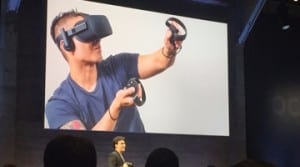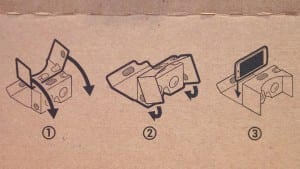99p Virtual Reality and the implications for video in HE
By Matt Jenner, on 16 November 2015
Consumer-ready virtual reality is just around the corner
Next year is touted as a potential for the ‘year of VR’ and as a wonderful precursor, people are already selling the hardware required for only 99p. Some are even giving it away. This will ripple into higher education with video being a likely contender for early adopters. But what is VR and how does one get it for 99p (or free)? Well you need a smartphone and around 10-15 minutes of your life…
What is VR?
Virtual reality was resting firmly in the ‘cold’ part of the ‘what’s hot’ spectrum for about 20 years; but over the last 18-24 months it has leaped from the ice to the fire in a rapid way. It is now so cheap you can have it for 99p; which smacks the technology depreciation/throw-away market so hard in the face it may have to reinvent itself too (some people already talk of throwaway tablets). But what does it mean, and why does higher education care?
If you want to find out about VR I’d point you back to a previous post, or you should search around the internet a little bit. It’s an emerging technology which places screens very close to your head, and sensors to know where you’re looking, to simulate you being in another environment. It also needs a computer to power the images you see, and the movements you make to look/move around it.
Oculus Rift is a simple example of a complex tech landscape. Popularised when bought by Facebook for $lots the technology plugs into your computer and can provide you with an experience which some say is immersive, and others say is nauseating or induces cybersickness. But please remember, these are developer units; they’re not consumer friendly (yet – Q1 2016 isn’t far off). This sickness is as close as you may ever want to get to experiencing a software bug!
Oculus, and many others, share a similar trait – they need a powerful computer to use them. I’ve tried it on my Macbook Air – I had forgot the machine had a fan; it became too hot to touch (near the back). The lagginess from the ultraportable didn’t help the sickness. All in all, eww & gross. Some other laptops are better, but it’s still a little off-putting when you’re new toy needs to be put away and you need to go lie down as recovery.
Enter: the smartphone.
Google Cardboard was a mini-revolution in the VR field. Being provocative, ‘not evil’ and generally idiosyncratic in their approach, Google released what seemed like the most basic VR product possible – Cardboard. This was a few years ago now but it enabled anyone with a smartphone to start playing/developing. Developers, techies and big children started buying these and exploring a new world.
Smartphone + Video = one way to VR
Your smartphone is insanely powerful for the size of it. It has a tiny display, a powerful CPU and GPU, motion sensors, location awareness, it is personalised and portable. Slotting it into a Google Cardboard now makes it a Virtual Reality device; as it can show content and sense your every movement. It’s also low-threshold, in some sense, because you are already comfortable with it. Video on smartphones is already mainstream. So what about 360, spherical or immersive video?

Waves over Grace – vrse.works. Source
One example is vrse.works who released two documentaries; Clouds Over Sidra and Waves of Grace. These two UN-backed ‘films’ were two, touching, compelling and utterly enthralling pieces of cinematic content. Watchers in a UN building, somewhere nice and safe, watched in Clouds Over Sidra how Sidra, a young girl in the Za’atari Refugee Camp and having fled from Syria, would offer a chance to explore her world. Chris Milk, Director at vrse.works commented in a TED talk how VR can be a bridge to empathy for the experiences of others.
99p VR
Google Cardboard wasn’t technically doing too much; it’s a complex puzzle the first time but you’re folding cardboard, adding lenses and sticking on a magnet. Children can do this; and many will this Christmas. The reason why? Cheap manufacturing has taken the cheap Google Cardboard and made it as cheap as the market can go; 99p! I have hunted on eBay and bought four of the rival offerings. I’ll report back with which is best, but from experience I am sure they’re all the same.
Free VR
Just to kick it to everyone – on Sunday 8th November 2015 the New York Times gave a free Cardboard VR kit to every reader. Just to make a point? At this stage it doesn’t really matter; it got VR into another new audience, NYT readers (or their family/friends). You might even know someone with an unused voucher from their digital subscription, or willing to share theirs. NYT also released an App to share content and introduce their first documentary shot for the giveaway. Maybe, just maybe, they know it’s a part of the future landscape of journalism (like VICE News knows already) and want to break their readers in gently…
Back to the content – video first
Google Cardboard is also an app for Android and iOS. It has a video player which links to YouTube, which now supports 360 and VR video. If that doesn’t mean anything to you – STOP – and load this link (on your smartphone is best)
Welcome back to 2015
People are already making this content and there is a whole YouTube channel dedicated to it. There are also an increasing amount of apps for games, simulations, experiences, stories, social networking, explorable environments and more.
So what about higher education?
Video is the first logical step for changing HE. Who has not tried, or considered, lecture capture yet? Obiquity is likely but not so for VR, not yet anyway. To make 360/VR/spherical video you’ll need at least a 360 degree camera, which are also still quite expensive. But with this you’ll be able to capture any environment, action or event that is taking place. The trick isn’t necessarily in the editing, it’s in the experience you’re trying to capture. Imagine a researcher on a field trip; taking the watcher to a place they simply couldn’t go. Lab experiments can capture multiple synchronous events. How about an event that is so hard to replicate that you’ve only really got one shot – a rocket launching, blue moon Panda birth-type thing. The kind of event you want to capture but can’t even predict what should be in the frame, and what shouldn’t. VR video offers the playback of the whole environment, the viewer choses what to watch. It’s experimental now; but the power shifts towards the experience of viewing. Additionally; cameras can go when you can’t send a person; a volcano, to Mars or into the body – all quite tricky.
Proper VR needs a powerful amount of hardware; 99p VR does not. Video is a way in.
Limitation, there are still a few:
- You need a smartphone. The cardboard on it’s own is only going to distort the back of a pice of cardboard – very real, not very virtual.
- The official Google Cardboard app is for Android and iOS and it has a load of great content already (and more coming).
- It’s 99p. It will not feel comfortable, it’ll break, get dirty easily and probably not hold all types of smartphone.
- The really cheap ones don’t come with a strap for your head, so it’s hands-up to hold it.
- They are not shaped to any head.
- You’ve still got to put a thing on your head. Daftness points++
Summary
Throw it around, take it places and share it with people. It’s so cheap that 99p cardboard VR is worth the experiment if you have a smartphone. Also once used (or you’ve got bored of it) pass it on. Someone else can try it.
Conclusions
VR is nauseating but it also bring people right into an experience. Bugs will be fixed, hardware will improve, but this lack of gap between cheap and professional is similar to disposable cameras and SLRs. Say what you will about the smartphone requirement but it’s ever-more true that the world is connected via these devices. If they can also deliver a VR experience (and soon, capture them), imagine what’ll it be like when we’re all making the content too. It’s unlikely to become an immediate new must-have, but VR is coming and lodging itself in.
Closing thought on distance learning and virtual reality
I am learning, but the power of giving cheap VR to distance learners is certainly something to keep an eye on. This is one of my topics for exploration during 2016. I think it offers a unique and unchallenged method for connecting remote people to important things. We’ll see where it goes.
 Close
Close



